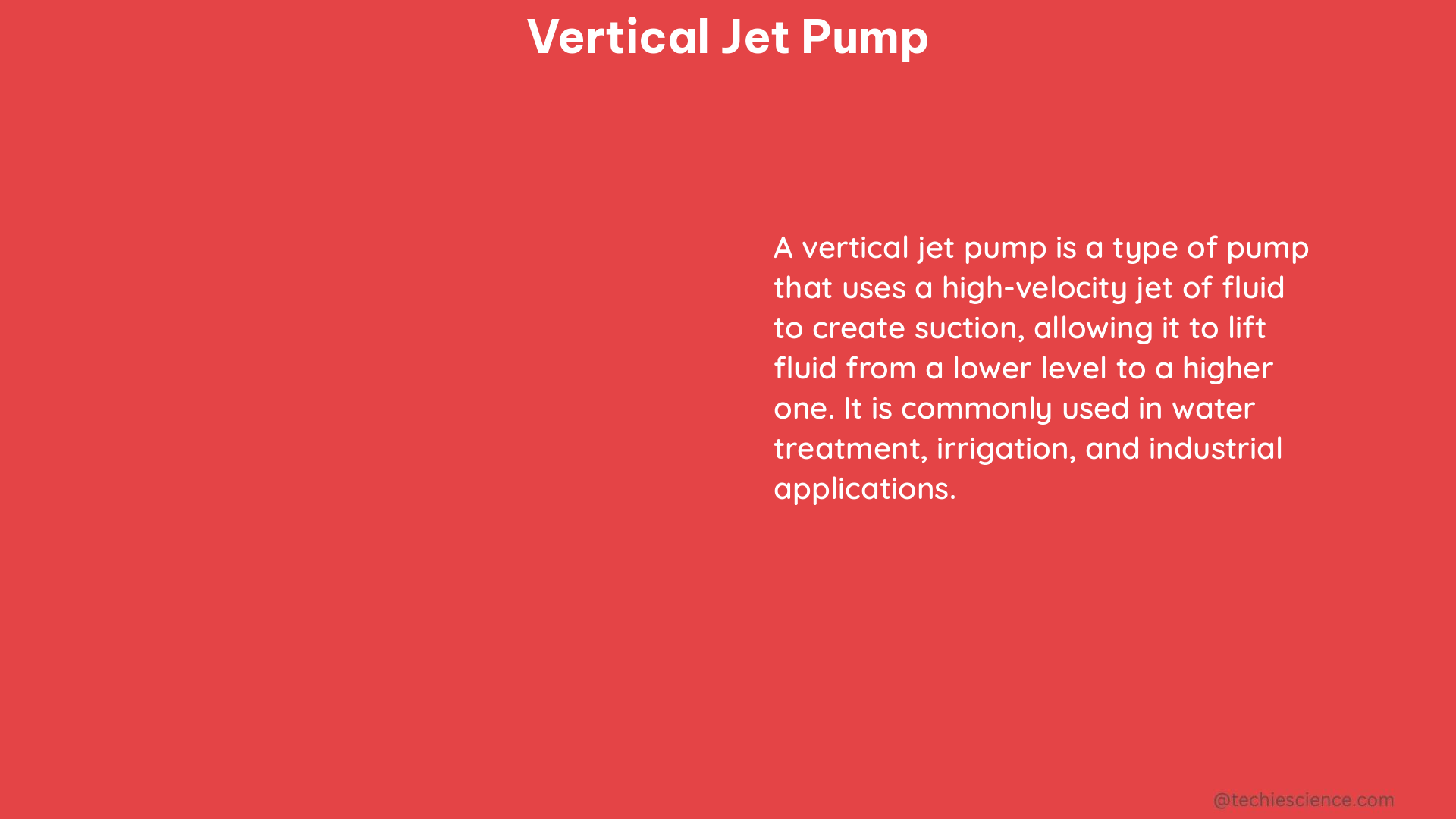The vertical jet pump is a versatile and efficient pump that utilizes the principle of jet propulsion to lift fluids from a lower to a higher elevation. This pump consists of a nozzle and a diffuser, which work together to accelerate and decelerate the fluid flow, respectively. The high-velocity fluid jet created by the nozzle entrains the surrounding fluid, creating a low-pressure region that sucks in additional fluid. This mixture of fluid and jet is then diffused, converting the kinetic energy back into pressure energy, which can be used to lift the fluid to a higher elevation.
Understanding the Vertical Jet Pump
Optimizing Pump Performance
The performance of a vertical jet pump can be optimized by adjusting various process parameters, such as:
- Area Ratio: The ratio of the diffuser exit area to the nozzle throat area, which affects the pump’s efficiency and suction capacity.
- Pressure Ratio: The ratio of the pump’s discharge pressure to the suction pressure, which determines the pump’s lifting capacity.
- Flow Rate Ratio: The ratio of the entrained fluid flow rate to the primary fluid flow rate, which affects the pump’s suction capacity.
- Density Ratio: The ratio of the entrained fluid density to the primary fluid density, which can impact the pump’s performance.
These parameters are interrelated and can be calculated using the characteristic and efficiency equations of the jet pump, which are derived from the principle of energy conservation. The optimal structural parameters for a jet pump can be calculated using a design methodology aimed at achieving the optimal pump efficiency while ensuring the minimum required lifting pressure ratio.
Suction Capacity and Dynamic Fluid Pressure
The suction capacity of a vertical jet pump is affected by the dynamic fluid pressure within the formation. When exposed to dynamic fluid pressure, the jet pump’s suction capacity increases significantly, while its lifting capacity remains relatively constant. This makes the jet pump an effective tool for sand suction in oil wells, where the presence of dynamic fluid pressure is common.
Improving Efficiency
The efficiency of a vertical jet pump can be improved by optimizing the process parameters and sand-flushing capabilities. However, there are limitations to the parameter optimization method based on the P-M curve, which necessitates the development of an engineering design evaluation method focused on maximizing suction force.
Technical Specifications and Sizing

Vertical Distance to Water and Friction Loss
In terms of technical specifications, a vertical jet pump can be sized based on the vertical distance to water and the friction loss in the piping system. The friction loss in the piping system can be calculated using charts provided by the pump manufacturer, which take into account the column pipe and shaft size, length, and flow rate.
Specific Capacity Calculation
The specific capacity of the pump can be calculated by dividing the flow rate by the drawdown of the water level, which is the difference between the pumping water level and the static water level. This calculation helps determine the pump’s performance and suitability for the intended application.
DIY Vertical Jet Pump Installation
Selecting the Appropriate Pump Size
When building a vertical jet pump for a DIY project, you’ll need to select the appropriate pump size based on the vertical distance to water and the friction loss in the piping system. This can be done by consulting the manufacturer’s charts and specifications, which provide guidance on the pump’s performance and sizing.
Calculating Specific Capacity
To ensure the pump meets your DIY project’s requirements, you’ll need to calculate the specific capacity of the pump based on the desired flow rate and drawdown of the water level. This will help you determine if the pump is capable of providing the necessary water flow and pressure for your application.
Installing the Vertical Jet Pump
Once you have selected and sized the pump, you’ll need to install it according to the manufacturer’s instructions. This includes properly aligning and securing the piping system, as well as ensuring the electrical connections are made correctly. With some basic plumbing and electrical skills, you can successfully install a vertical jet pump for your DIY project.
Conclusion
The vertical jet pump is a highly efficient and versatile pump that can be used for a variety of applications, including DIY projects. By understanding the pump’s performance optimization, suction capacity, and technical specifications, you can select and install the appropriate vertical jet pump for your needs. With the right knowledge and skills, a vertical jet pump can be a simple and effective solution for your DIY water management projects.
References:
– Jia, X., Liao, H., Hu, Q., He, Y., Wang, Y., & Niu, W. (2023). Optimization Method of Jet Pump Process Parameters and Experimental Study on Optimal Parameter Combinations. Processes, 11(10), 2841.
– IRIS. (n.d.). Page 7: Challenging, Ambitious, Measurable Annual Goals. Retrieved from https://iris.peabody.vanderbilt.edu/module/iep01/cresource/q3/p07/
– A.Y. McDonald Mfg. Co. (n.d.). 2-Pump Basic-Sizing.indd. Retrieved from https://www.midc-ent.com/Pump%20Basic-Sizing.pdf

The lambdageeks.com Core SME Team is a group of experienced subject matter experts from diverse scientific and technical fields including Physics, Chemistry, Technology,Electronics & Electrical Engineering, Automotive, Mechanical Engineering. Our team collaborates to create high-quality, well-researched articles on a wide range of science and technology topics for the lambdageeks.com website.
All Our Senior SME are having more than 7 Years of experience in the respective fields . They are either Working Industry Professionals or assocaited With different Universities. Refer Our Authors Page to get to know About our Core SMEs.